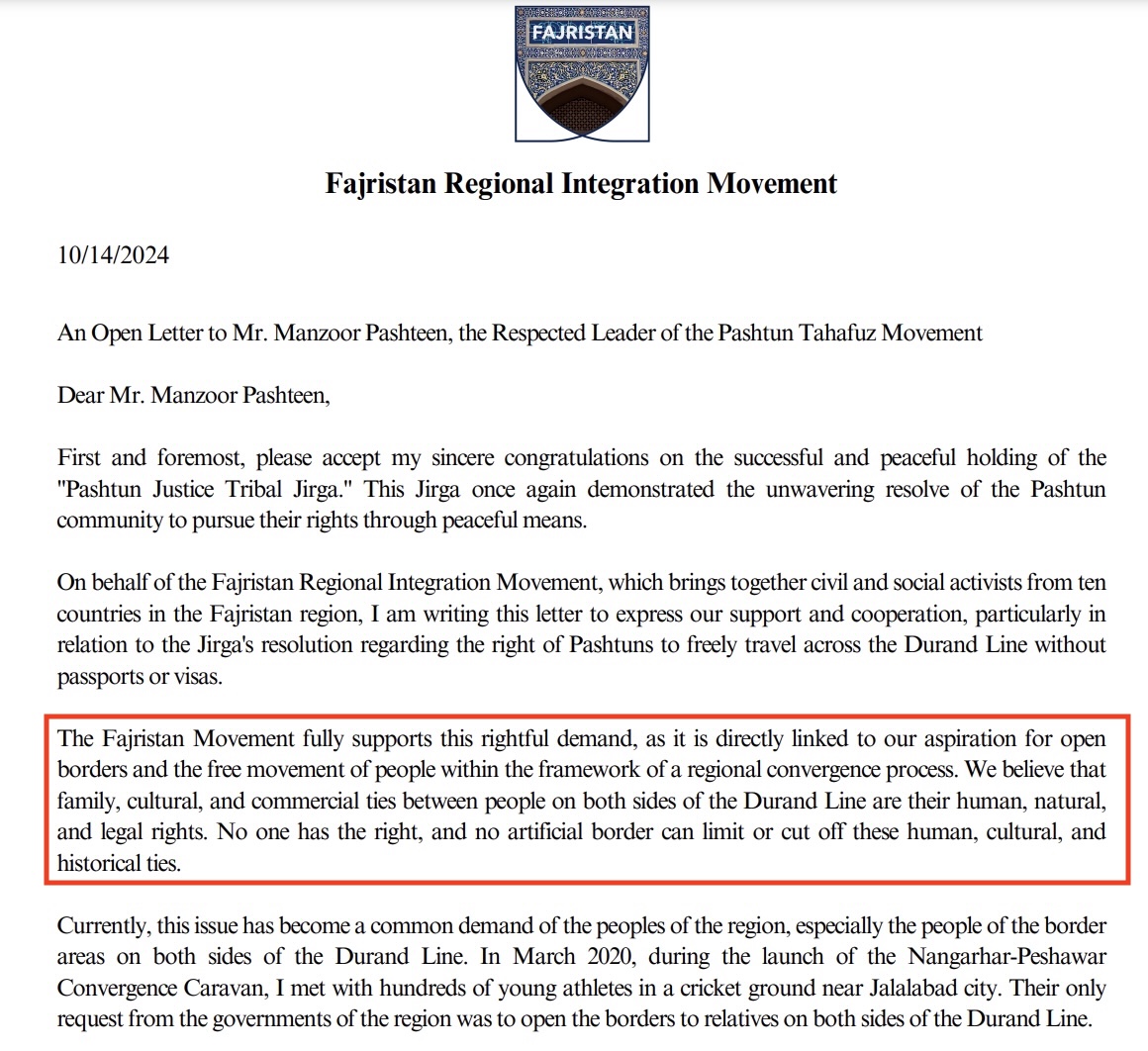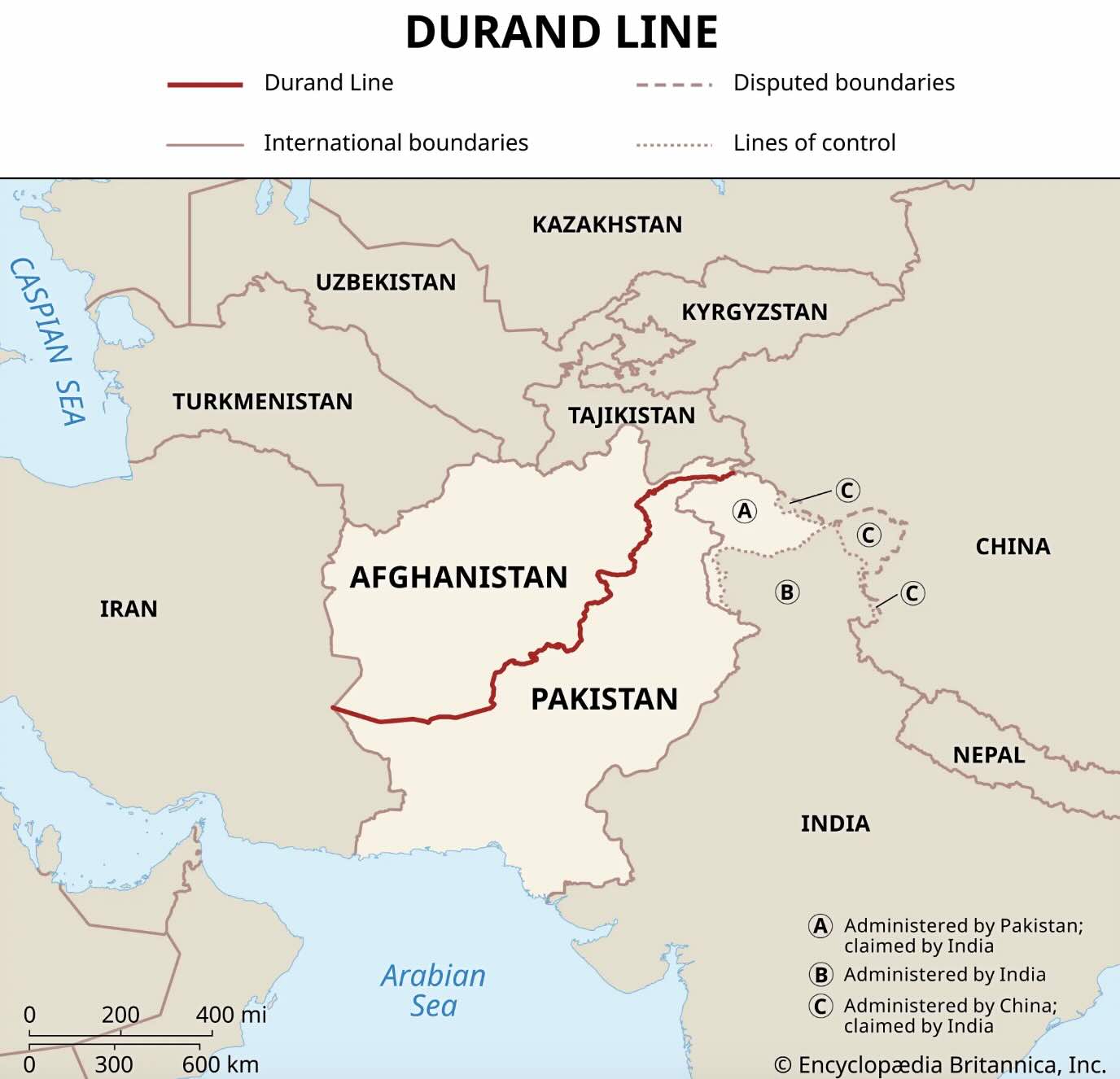For nearly a century, the Durand Line—drawn by the British in 1893—has divided the Pashtun population between Afghanistan and Pakistan. This border has not only fueled political tensions between the two countries but has also severely impacted the daily lives of Pashtun communities living in the border regions.
“Family, cultural, and commercial ties between people on both sides of the Durand Line are their human, natural, and legal rights,” writes Mohibullah Noori, President of the Fajristan Regional Integration Movement, in an open letter to Pashtun leader Manzoor Pashteen. Noori proposes a bold plan to resolve the century-old Durand Line dispute, advocating for open borders, regional integration, and the free movement of people.

A Call for Open Borders and Integration
The Fajristan Regional Integration Movement, which represents civil and social activists across ten countries in the Fajristan region, has long advocated for regional convergence and open borders. In the letter, Noori extends the movement’s full support for the recent resolution of the Pashtun Justice Tribal Jirga, which demands the right of Pashtuns to travel across the Durand Line without passports or visas.
“The Fajristan Movement fully supports this rightful demand, as it is directly linked to our aspiration for open borders and the free movement of people within the framework of a regional convergence process,” writes Noori. He emphasizes that family, cultural, and commercial ties between people on both sides of the Durand Line are “human, natural, and legal rights.”
The Impact of the Durand Line on Pashtuns

Noori recounts a harrowing visit to the Torkham Gate, one of the key border crossings between Afghanistan and Pakistan, where he witnessed the suffering of local residents. “One of the most heartbreaking moments was meeting an elderly man who said, ‘I am stuck here, but my body is on the other side of the border, and we cannot transfer our dead.’”
He also recalls a tragic stampede in 2020 at a football stadium in Jalalabad, where thousands of people were attempting to secure Pakistani visas. “In this incident, 12 women were killed and 12 others, including 9 women and 3 men, were injured,” Noori writes, expressing frustration over the closed borders and lack of cooperation between the two governments.
The Fajristan Movement’s Plan
Noori argues that resolving the Durand Line dispute is critical for achieving peace, stability, and economic development in the region. The Fajristan plan, developed over two decades of research and practical experience, proposes a four-stage process to address the issue. The plan aims to protect the territorial integrity of both Afghanistan and Pakistan while ensuring the rights of the Pashtun people.
Stage One involves a political agreement between Afghanistan and Pakistan, where both governments would recognize the Durand Line as an international border and remove border barriers to allow the free movement of people. Noori compares this to treaties within the European Union, suggesting that a joint institution could be established to monitor the agreement.
Stage Two would focus on securing the borders through the creation of a joint Afghan-Pakistani border force. This would reduce security threats and ensure stability in the region, which is vital for implementing the political agreement.
Stage Three involves reopening the borders and abolishing passport and visa requirements, allowing people to travel freely and promoting cross-border trade. According to Noori, this step would “strengthen family and social ties and contribute to economic prosperity in both countries.”
Finally, Stage Four proposes joint economic and cultural development projects in the border regions, focusing on infrastructure, free trade, job creation, and the empowerment of women and youth. Noori stresses that the border areas on both sides form “an inseparable social and geographical unit,” and development on one side is not possible without progress on the other.
A Call to Manzoor Pashteen
The letter concludes with a direct appeal to Manzoor Pashteen, the leader of the Pashtun Tahafuz Movement (PTM). Pashteen, known for his advocacy of Pashtun rights, has become one of the most influential voices in the region, particularly regarding issues of human rights and military abuses in Pakistan’s tribal areas.
Addressing Pashteen, Noori writes, “I urge you as the youngest and most popular leader of the Pashtun community to support this plan. With your approval, this plan can first be shared with the members of the Jirga and then, after their agreement, presented to the Pakistani government and the future legitimate government of Afghanistan.”
The Path Forward
The letter from the Fajristan Movement reflects a broader desire for peace and cooperation in a region long torn apart by conflict and political divisions. By proposing a pragmatic and peaceful solution to the Durand Line issue, Noori hopes to foster a new era of collaboration between Afghanistan and Pakistan, with the Pashtun people at the heart of this effort.
Whether Manzoor Pashteen and other regional leaders will embrace this vision remains to be seen, but the letter offers a powerful reminder of the human toll of political divisions—and the possibility of a better future through regional cooperation.
Who are the Fajristan Regional Integration Movement and The Pashtun Tahafuz Movement (PTM)
The Fajristan Regional Integration Movement is a coalition of civil and social activists from ten countries within the Fajristan region, which spans parts of Central and South Asia. The movement advocates for regional cooperation, open borders, and the peaceful resolution of longstanding disputes, including the Durand Line conflict. Its president, Mohibullah Noori, has been a vocal proponent of regional integration as a pathway to peace and development.
The Pashtun Tahafuz Movement (PTM) is a grassroots movement that emerged in Pakistan in 2018, led by Manzoor Pashteen. The PTM calls for an end to military operations in Pakistan’s tribal areas, accountability for enforced disappearances, and the restoration of basic human rights for Pashtuns. The movement has gained significant support among Pashtuns on both sides of the Durand Line, highlighting the deep-seated grievances of the Pashtun community.
Comments (0)